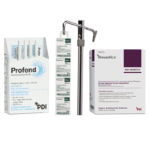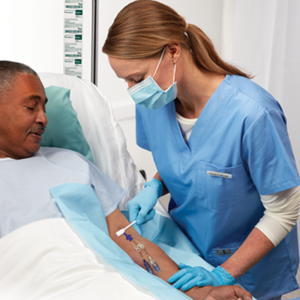Interventional Care


We notice that you are visiting us from . This site only services US-based visitors. Would you like to visit the site that is appropriate for your location?

Every Infection Preventionist should know what The Center for Disease Control and Prevention’s (CDC) bundle checklist is to prevent CLABSIs (1):
As facilities continue to strive for zero infections, following all aspects of the bundle has never been more important. However, studies show that even though this is the case, there continues to be huge variances in the consistency in processes of nurses caring for central lines, with one study showing that 31% of healthcare workers failed to disinfect the needleless access site prior to use (2), and another study showing differences that range from 6% to 51% compliance with scrubbing the hub (3).
The CDC ‘s 2017 National and State Healthcare-Associated Infections Progress Report showed that in acute care settings alone there were 21,173 CLABSI’s reported to NHSN (4). The CDC also states in the report that “Each day, approximately one in 31 U.S. patients contracts at least one infection in association with his or her hospital care, underscoring the need for improvements in patient care practices in U.S. healthcare facilities. While much progress has been made, more needs to be done to prevent healthcare-associated infections in a variety of settings.”(4)
How can PDI help?
Working as an Infection Preventionist and Clinical Science Liaison for PDI, I have had the unique opportunity to see firsthand a snapshot of what compliance with this bundle looks like. Through our clinical service, we offer facilities who are adopting the Prevantics® Device Swab for scrubbing the hub, a comprehensive assessment with a trained Infection Preventionist to ensure the facility is compliant and that all recommended central line practices including central line maintenance are followed. Since PDI’s Infection Preventionists are not associated with an official survey agency or levying any citations, these audits are able to be performed in a non-threatening and supportive manner to allow for an accurate glimpse into what actually is happening on the nursing units. Assessments typically span a 48-72 hour period and include all shifts. All parts of the bundle are critically assessed. From my own personal experience at observations made within these assessments, the statistics quoted above are sadly very true.
Since the evidence is clear that compliance with scrubbing the hub is so poor, is there any hope that facilities might improve?
Scrubbing the hub with alcohol takes a minimum of 15-30 seconds to properly disinfect a needleless access device, however scrubbing the hub with alcohol and Chlorhexidine (CHG) takes only a brief 5 seconds to achieve complete disinfection (5). The “magic” lies in the Chlorhexidine. Chlorhexidine is a positively-charged molecule that binds to the negatively-charged sites on the cell wall; it destabilizes the cell wall and interferes with osmosis. This typically happens within seconds of exposure to CHG (6). Chlorhexidine is broad spectrum, and is effective against gram positive organisms, gram negative organisms, and fungi. Chlorhexidine has been found to have the unique ability to bind to substances and be released slowly over time which gives a prolonged antimicrobial effect.Unlike alcohol alone, CHG and alcohol wipes work even in the presence of blood and bodily fluids.
Why is all of that important?
Over the past 15 years significant evidence continues to emerge that when needleless connectors are scrubbed prior to access using a CHG and alcohol combination versus alcohol alone, CLABSI rates not only drop, but are sustained. Part of this is due to the very potent antimicrobial combination, but perhaps the more important piece of the puzzle is the fact that when nurses scrub the hub using CHG and alcohol, they only have to scrub for five seconds to achieve disinfection which nearly eliminates poor compliance and variances in the scrub the hub practices we see across the nation.
A great example of a facility that has achieved amazing results using this method is Doctor’s Medical Center in Modesto CA. Over ten years ago, Janet Pettit, a nurse practitioner in the neonatal intensive care unit, was dismayed at their alarmingly high CLABSI rates. Her focus and dedication around helping her vulnerable patients led her to help form an interdisciplinary collaborative with the goal of CLABSI reduction. Using pioneering science, and with a comprehensive plan in place, a practice change was implemented changing cleaning of the needleless connectors used to enter all peripheral and central vascular access devices from an alcohol wipe to an alcoholic CHG (3.15%) wipe. Although the alcoholic CHG wipe was FDA approved for skin antisepsis prior to injection, cleansing/disinfecting of medical devices was considered off label use at the time. However, the chemical solution was widely described in the literature for this prescribed purpose with positive results. The process for cleaning the needleless connector was unchanged though included scrubbing with friction ten times with the alcohol CHG wipe and allowing complete drying prior to entry. As a direct result, CLABSI rates dropped from 7.1/1000 catheter days in 2008 to 0.56/1000 catheter days in 2009 with only one CLABSI occurring during the entire year (8).
So what? You may say. This was in 2009! I need help TODAY. Well let’s catch up with this hospital and see if this practice is still working. Over ten years later, Amy Paradis, a nurse practitioner who followed in her colleague’s footsteps, presented a poster at the National Advanced Practice Neonatal Nurses Conference in Palm Springs CA on May 29th 2019. In this abstract, she describes the ongoing journey of the very same NICU and their adherence to the methods that Janet founded. By continuing with the best practices that were proven to work, their unit sustained ten years with ZERO CLABSI’s!! “Countless babies are celebrating birthdays they may never have realized!” said Amy Paradis. Amy continues to describe that through Janet’s groundbreaking work and dedication to science “she made a difference for so many others in our field” (9).
There is indeed hope for those struggling in their own journeys to reach zero, and that zero IS an attainable goal.
By utilizing practices for scrubbing the hub that set nurses up to succeed, patients are protected and CLABSI’s are avoided. My own personal experiences seeing hospitals across the nation struggle with this issue just reinforces to me the great need for a practical easy to follow process and a product that fits this gap.